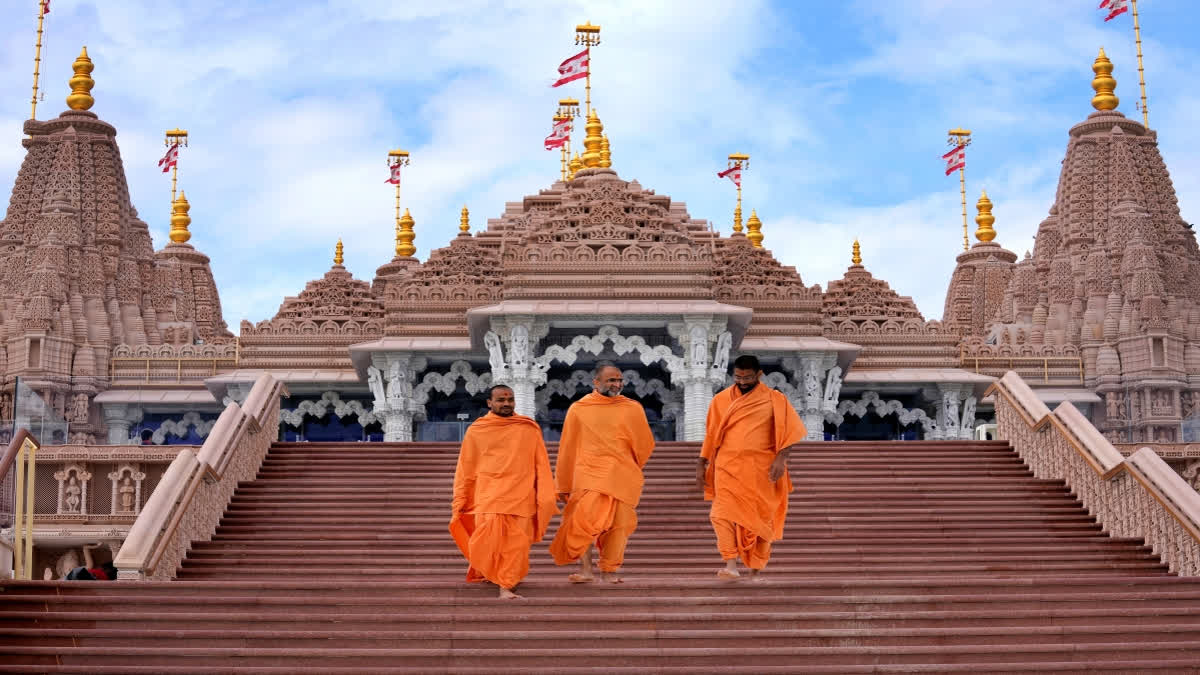Abu Dhabi: The first traditional Hindu stone temple in the United Arab Emirates (UAE), BAPS Hindu Mandir, opens its doors to devotees here on February 14.
Prime Minister Narendra Modi, who is on his seventh visit to UAE, is slated to inaugurate the Mandir.
The soon-to-open BAPS Hindu Mandir signals just how far the United Arab Emirates has come in acknowledging different faiths of its expatriate community, long dominated by Indians who power life across its construction sites and boardrooms.
Here's everything you should know about the BAPS Hindu Temple:
- BAPS (abbreviated as Bapu Samaj Samartha Samartha) is a social-spiritual, Hindu faith based on the Vedas. It was founded in the late eighteenth century by Bhagwan Swaminarayan (1781–1830) and formally established by Shastriji Maharaj (1865–1951) in 1907.
- BAPS is based on practical spirituality and seeks to address spiritual, moral and social issues in today's world. The strength of BAPS lies in its purity of purpose and intentions. BAPS has a worldwide network of more than 3,850 centers and its outreach has won many national and international accolades. BAPS also has affiliations with renowned organisations such as the United Nations.
- The project was conceptualised soon after Prime Minister Modi came to power in 2014. During his visit to the UAE in 2015, the government allocated land to the temple. This was an important decision as it was the first time Prime Minister Modi visited the strategic Gulf state in 34 years after Indira Gandhi's visit.
- After his visit, the Government of the UAE issued a Royal Decree to provide 13.5 Acres of land to the BAPS Mandir. The Government of the UAE also allocated an additional 13.5 Acre to the BAPS in 2019. This brings the total amount of land allocated to the BAPS to 27 acres.
- The foundation stone was laid by Prime Minister Modi through video conference from Dubai Opera House on his 2nd State Visit to the Arabian Nation in 2018. However, the stone was laid in April 2019. The construction of the Mandir began in December 2019.
- Built at a cost of a whopping ₹700 crores, the temple is poised to be the biggest Hindu mandir in West Asia. The stunning architectural marvel holds a prayer hall having a capacity of 3,000 people, a community centre, an exhibition hall and several other attributes.
- The temple measures 32.92 meters in height (108 feet), 79.86 meters in length (262 feet), and 54.86 meters in width (180 feet). Crafted by Indian artisans, and assembled in the United Arab Emirates, the temple covers approximately 55,000 sq meters of land. It is constructed using 1.80 lakh square meters (50,000 cubic feet) of rose pink sandstone, 1.50 lakh square meters (18,000 square feet) of pure white Italian marble, and 18,000 bricks.
- The rose pink sandstone and the white Italian marble stone have been carved in India and were assembled in the UAE over the past 3 years. The 402 white marble pillars have been carved by over 2,000 craftsmen from Rajasthan & Gujarat. The design is based on Vedic architecture and sculpture.
- The temple shrine dedicated to lord Shiva shows verses from the Shiva Purana and displays the 12 Jyotirling domains, while the shrine of lord Krishna shows the celebration of the ‘Jagannath Yatra’. The stories from the Bhagwat and the Mahabharat come alive in the shrine of Lord Krishna.
- Just like the Ram Mandir in Ayodhya, this temple has been constructed without using iron and steel. It has assimilated ideas from the Arabian region, the Chinese, the Aztecs and the Mesopotamians. The temple has seven shrines dedicated to different deities from different parts of India, such as Lord Ram, Lord Hanuman, Lord Shiva and his family, Lord Jagannath, Lord Krishna, Shri Ashkar-Purushottam Maharaj, Lord Tirupati Balaji, and Lord Ayyappa. Each shrine is adorned with intricately carved carvings that reflect the life and lessons of each deity.



